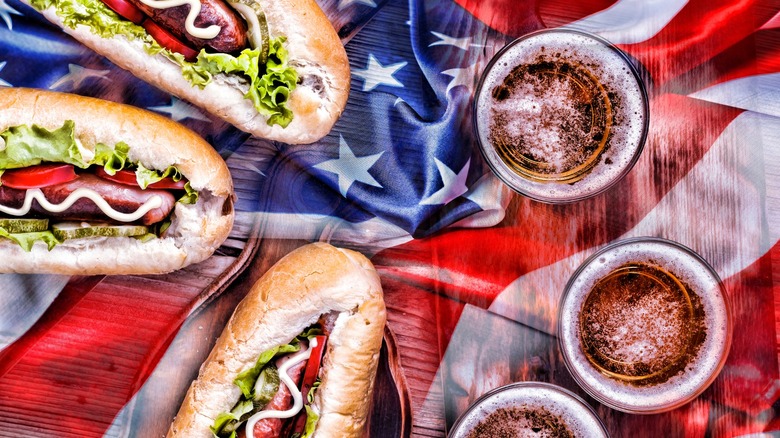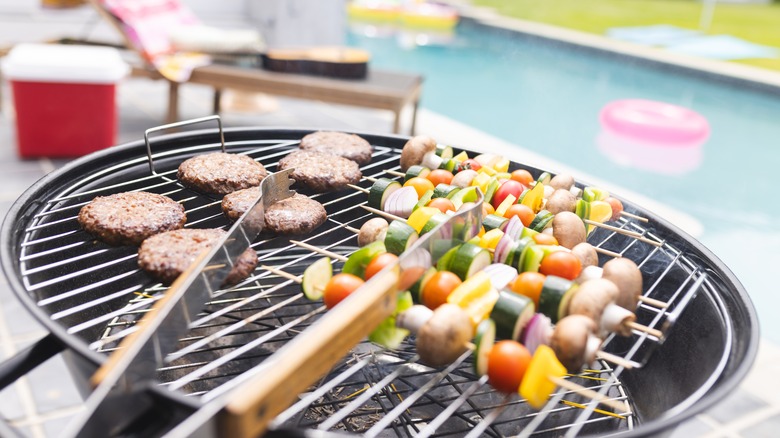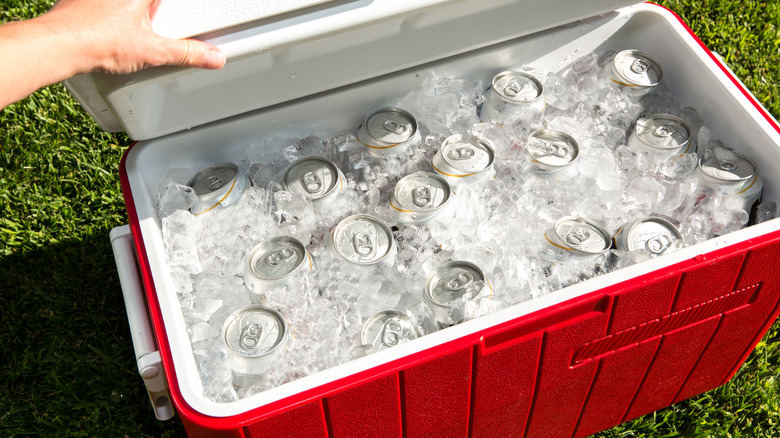How To Keep Food Warm Or Cold For Your Labor Day Cookout
Labor Day is the second-most popular day for grilling in America, right behind the Fourth of July, and for good reason — unless you live in Florida, Hawaii, or Southern California, it could be the last three-day weekend where the weather is nice enough for outdoor festivities. Since the event might serve as the grand finale to grilling season, it's important not to screw up your Labor Day cookout but end on a high note instead: full bellies for all, with no trips to the emergency room for food poisoning. The key to a successful celebration (food-wise, at least) can be summed up in two words: temperature control.
Sounds boring? Maybe, but if you fail to consider food temperature, you may wind up with cold burgers, warm beer, melted ice cream, and guests who leave en masse to hit up the nearest drive-thru. If you're hosting a get-together in your own backyard, you can always get around this by keeping the hot foods in a 200-degree Fahrenheit oven and the cold stuff in the fridge or freezer. Transport items outside on an as-needed basis, bearing in mind that perishable food shouldn't sit out at room (or yard) temperature for more than two hours lest it begin breeding harmful bacteria. If you'll be gathering at a park or picnic pavilion, however, you may need to bring some necessary equipment to ensure your food remains at its optimal heat level.
There are several ways to keep your hot food hot
It should be relatively simple to ensure that any foods you've cooked on the grill stay warm since all you need to do is create a cool zone with a lower temperature than the hot zone where the cooking took place. If you have a gas grill, just turn one or more of the burners off and leave the grilled meats, vegetables, fruits, or what have you sitting atop the unlit burners. If you're cooking with charcoal, pile the hot coals on one side and use this for cooking. The coal-free side will be where you keep the food warm.
If you have access to electrical sockets, you can keep any hot side dishes such as baked beans or macaroni and cheese in slow cookers, rice cookers, or chafing dishes set on "warm." If this is not possible, an insulated casserole cover is one of the best products you can buy to make your backyard barbecue better. If you don't already own one and your budget won't run to purchasing another accessory, you can improvise with a cooler or insulated shopping bag, since both of these trap heat as well as cold. Even a lidded baking dish will help the food stay warm — metal lids or DIY foil ones work best as they reflect the heat back into the food where it belongs instead of allowing it to leak out.
It takes ice, ice, baby to keep your cold food chillin'
While hot food usually tastes okay if you eat it when it's merely warm-ish, cold food is a different story. The two-hour clock starts ticking on mayonnaise-based sides at temperatures over 40 degrees Fahrenheit, while ice cream might turn into a puddle within minutes on a hot day. As for not-so-cold drinks, umm, nobody drinks warm beer but the British, and even they might say no to a lukewarm soda. To keep these things cold, you're going to need a cooler, or more likely, quite a few coolers, all packed with ice. Pre-chill your cooler if you can, and pack it as full as possible starting with a layer of ice on the bottom. As a general rule of thumb, expect to use twice as much ice as there is food to chill.
If you run short on cooler space, save it for the drinks and ice cream, since we've got a handy hack that should work for your potato salad. Freeze a few pie pans half-filled with water, then place one under the salad bowl. Cover the salad in foil (this stuff helps keep food cold as well as hot), put another ice pie on top, and wrap everything in an insulated bag. Yay for improvisation! For safety's sake, though, you should be finishing up the salad within two hours of taking it out of the bag (or one hour, if the temperature gets above 90 degrees Fahrenheit).


